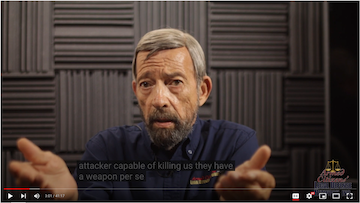Disparity of Force
Massad Ayoob with moderator Marty Hayes
Reviewed by Gila Hayes
Last month Massad Ayoob and Marty Hayes recorded a new member-education video that teaches about disparity of force. In this video, they analyzed incidents in which armed citizens shot ostensibly unarmed assailants. While it seems that prosecutors are quick to paint shootings like these as murder or manslaughter, testimony by the defendant and expert witnesses can show why shooting was a reasonable response to an attack by someone who did not possess a firearm. When disparity of force is skillfully explained at trial, judges and juries recognize the danger the aggressor posed and acquit the defendant, Hayes explained by way of introduction. Ayoob then discusses details drawn from trials that have been in the headlines as he explains the application of the disparity principle in justifying a self-defense shooting.
Ayoob kicks the lesson off by defining the underlying terms. He states, “We’re talking about the use of deadly physical force.”
The law defines deadly force as, “That degree of force that a reasonable, prudent person would consider capable of causing death or great bodily harm – great bodily harm being defined as a crippling injury, a severe injury, or a seriously disfiguring injury. Now, one is justified in using that level of force only in a situation of immediate and otherwise unavoidable danger of death or great bodily harm to oneself or an innocent party.”
Next, Ayoob identifies three key elements and why all three must be present to justify use of deadly force in self defense. They are ability, opportunity and jeopardy. Jeopardy, he states, is the assailant’s intent “manifest ... by words and or actions ... to kill or to cripple an innocent party.” Opportunity, which is nearly self explanatory, often speaks to proximity. Is the attacker close enough to inflict the deadly harm his words and actions promise? Ability is generally attributed to having a gun or knife – a weapon per se. Ayoob expands that definition, describing how an attacker who has no weapon at hand can use “his physical advantage over you” so effectively that “if this attack is allowed to continue you’re likely to be killed or crippled.”
“Physical advantage” does not apply only to larger, stronger aggressors attacking small, weak people, Ayoob continues, describing how multiple attackers, an attacker with skill in unarmed combat, a man attacking a woman, an adult attacking a child, or an attacker aggressing on someone in a disadvantaged position like knocked down on the street, all give such an advantage to the attacker that, in those circumstances, the disparity factor becomes a de facto weapon.
Defense attorneys get little to no instruction about disparity of force during their education, Ayoob warns, identifying another reason the Network distributes this kind of educational material to our members. The risks to a vulnerable victim are, perhaps, best illustrated by the “egg-shell skull,” a legal principle that holds an assailant – who strikes with no justification – responsible for unexpected physical harm sustained by someone who, on the surface appeared as hale and hearty as the aggressor. A judge might say, “The assailant takes the victim as he finds him. You had no right to hit that man at all. His eggshell skull is not what caused his death; what caused his death was you unlawfully punching that man for no good reason. This court finds you guilty of manslaughter,” Ayoob states.
Ayoob cites high-profile court cases that illustrate how poorly the criminal justice system grasps disparity of force principles. The cases underscore the “nearly knee-jerk reflex” causing prosecutors to charge vulnerable victims who shoot their attackers. His commentary encompasses the trials of Kyle Rittenhouse and Curtis Reeves, and identifies the actions of their assailants that created the risk of death or grave bodily harm. I followed both cases, as did many members, and in listening to Ayoob, I learned several facts about Reeves’ situation that the mainstream news obscured. Ayoob concludes that in both cases, the evidence showing the actions of the aggressors proved the deadly danger they presented. Rittenhouse and Reeves were acquitted “but in each case they had to go through the tremendous ordeal of trial,” he adds.
Disparity of force is not limited to physically frail victims, illustrated by Larry Hickey’s trials on which Ayoob and Hayes both worked. After two trials ended with hung juries, a judge gave a directed verdict that acquitted the defendant. Hickey’s ordeal began when three neighbors swarmed the healthy 30-year old in his driveway. The story of their attack gives examples of multiple attackers, aggressors of greater height, an attacker with skill in martial arts, and the in-the-moment debilitating effect of starting to lose consciousness after being sucker-punched in the head. Ayoob relates how the prosecution stressed that Hickey’s shots could not be self defense because the attackers weren’t armed. In addition, during deliberations in the second trial, an attorney seated on the jury told his fellow jurors, “This is all BS. I’m a law school graduate and an attorney. There’s no such thing as disparity of force. They made it up.”
In the years since that trial, Ayoob has been told by a number of attorneys that in three years of law school, they never heard the phrase “disparity of force” while being taught about the many, many other facets of law. He worries that ignorance on this topic will result in a continuing stream of cases like Hickey’s, Rittenhouse’s or Reeves’ and adds toward the end of the video, “Disparity of force is an element that comes up much more than you think it would and I can’t imagine why they don’t discuss it more in law school.”
Network members can view the lecture at https://armedcitizensnetwork.org/disparity-of-force-video . Login is required; if you need username or password help, please email or call us at 888-508-3404 during business hours.
